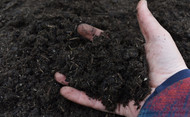Carefully. Since it involves burning plant material, please check with your municipality and your fire department to see if it’s allowed and if there are any requirements or permits needed. If your area is in a drought, be especially careful. All fire safety cautions should be observed, including but not limited to having a way to put the fire out in case things get out of hand, keeping it away from any structures, and never leaving the fire unattended ever. Check with your local fire department. They would much rather you ask them for help now than call for help later.
Biochar is different from charcoal because it burns at a lower temp with less oxygen than charcoal. One of the easiest ways to make biochar is to dig a trench deep enough to fit the biomass. A foot or two deep and as wide as you want and have material to fill it. If you have heavy clay soils, you may need one of these. Less compacted soils, you should be able to use one of these.
Fill your trench with leaves, sticks and small branches. Dry material works best. You want a hot fire that burns clean. You keep adding material, carefully. You don’t want to smother the fire but you also don’t don’t want everything to burn too fast. There’s a bit of a learning curve, and with experience, you will figure it out. You want to keep the fire going, without any smoke. Some smoke in the beginning is okay. Your material may have some hidden moisture that needs burning off. Once everything is burned and ash is starting to form on what remains, now is the time to slow things down. Cover the trench with the soil. You need to cut off oxygen to the fire, which lowers the temperature and slows the burn rate to produce biochar. You need to make sure that you completely cover the trench and that there’s no smoke escaping from anywhere. And now you wait. On average it may take five hours to complete the transformation into biochar. You can do a test by digging a hole. If you see smoke, cover it back up and wait some more.



